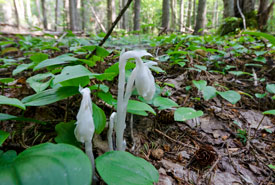
Ghost pipe, Holman's Island, PEI (Photo by Sean Landsman)
Ghost pipe
The ghost pipe, also called the ghost plant or corpse plant, is a perennial wildflower that gets its name from its shape and its pure, pale white colour. Unlike most other plants, this species does not produce chlorophyll, the green pigment used for photosynthesis. As a result, it is completely white (including its stem and scale-like “leaves”) and non-photosynthetic. It obtains energy through myco-heterotrophy — a relationship where plants obtain food through parasitism rather than photosynthesis. This plant relies on a large network of roots and fungi to “steal” energy from surrounding plants.
The ghost pipe’s stem is pale white and waxy. It measures 10 to 30 centimetres tall, ending in one white flower made up of five parts. It flowers from June to September.
When the plant first emerges from the ground and its flower opens, its flower points downward. As it matures, it gradually straightens until its flower is pointed directly upward.
Where is it found?
The ghost pipe grows in mature, moist, shaded, humus-rich forests across Canada, Alaska and most of the United States.
What is its conservation status?
The ghost pipe’s conservation status has not been listed by the Committee on the Status of Endangered Wildlife in Canada or the International Union for Conservation of Nature. However, it is considered at risk in Alberta and several U.S. states.
What is NCC doing to protect habitat for this species?
Ghost pipe has been documented on over 100 Nature Conservancy of Canada (NCC) properties across Canada, including in central Cape Breton, the Manitoulin Island Archipelago and Salish Sea.





